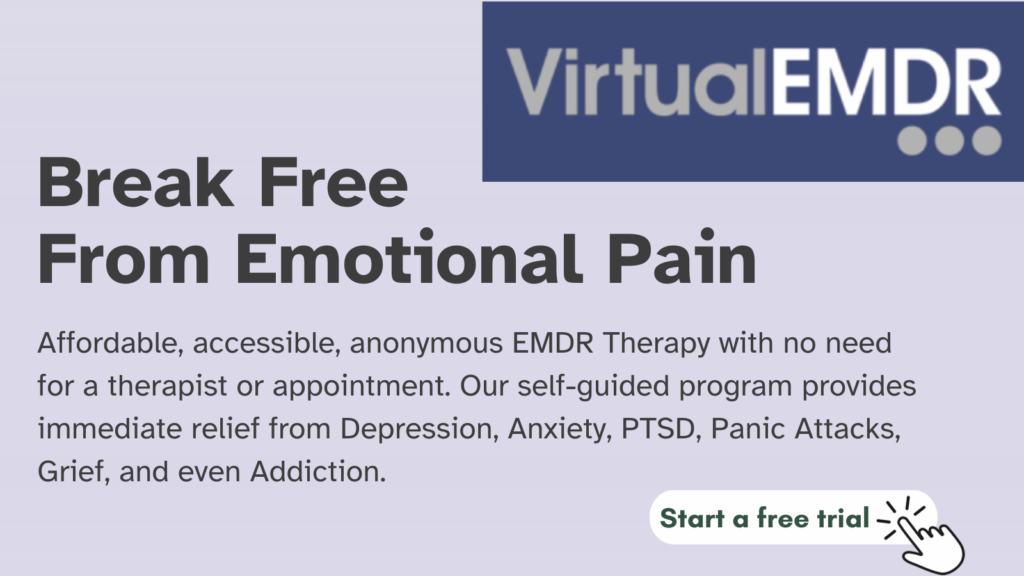In this post you’ll learn all about brainspotting and EMDR and the difference between the two.
What Is Brainspotting?
Brainspotting (BSP) is a type of alternative therapy that taps into and harnesses the body’s natural self-healing ability.
BSP uses spots in a person’s visual field to help them locate, access, and process trauma in the subcortical brain – the area of the brain responsible for motion, consciousness, emotions, and learning.
Related: How to Practice Self-Brainspotting Safely?
Brainspotting Process
In a Brainspotting session, the therapist usually inquires about what the person wants to work on and then determines if they are activated around it.
When the brain is in a resting state, it looks very different from one that’s active and for Brainspotting to work, the person needs to be activated or distressed.
If you’re not already activated around the issue the person has, the therapist will guide them to go inside and do what they need to activate themselves.
Then to measure the level of activation, the therapist will use the Subjective Units of Disturbance Scale (SUDS).
This scale rates the level of activation or disturbance around an issue from zero, which is neutral to ten, which is the highest.
After the SUDS level is determined, the therapist would ask something like, “Where do you feel the activation in your body right now?”
Body activation is often felt in the head, throat, chest, stomach, or back.
Now the therapist will try to find the Brainspot by slowly moving the pointer across the person’s visual field at eye level, starting at either the left or the right.
Once the brainspot is determined, the client is guided to mindfully observe their inner process with an attitude of curiosity and openness.
This is when the processing of the issue takes place.
At the end, the SUDS is rated again.
What Is EMDR?
EMDR (Eye Movement Desensitization and Reprocessing) is a psychotherapy treatment that was proven to alleviate emotional distress associated with stressful or traumatic life experiences.
EMDR uses bilateral stimulation (visual, auditory or tactile) in a rhythmic left-right pattern to activate and integrate information from the brain’s two hemispheres.
Does EMDR Work?
Since its initial development in 1987, EMDR has been empirically supported by randomized controlled trials (RCTs) and is internationally recognized as an effective treatment for trauma and other disorders.
Repeated studies show that EMDR provided the same benefits of psychotherapy for PTSD that once took year, in as little as 12 sessions. (*)
One of the studies using a mixed sample reported an 84% remission of PTSD diagnosis within 3 sessions of EMDR therapy. (*)
Who Is Not A Good Candidate For EMDR?
If you tend to feel overwhelmed or shut down when you feel an emotion, EMDR might not be ideal for you.
This is mainly because EMDR therapy relies on your body and mind’s ability to process your thoughts and feelings.
Related: 9 Scientifically Proven Trauma Therapy Approaches to Recover From Complex Trauma
Brainspotting Vs EMDR
Both EMDR and Brainspotting are supported by research evidence for the treatment of a variety of mental disorders. However, comprehensive research comparing the two therapies is lacking.
EMDR and Brainspotting both make use of the eyes.
But EMDR uses bilateral stimulation, including movement of the eyes from side to side while you process stressful or traumatic memories, while Brainspotting utilizes a single spot or position.
With Brainspotting, once a brainspot is located, you focus on that spot while you process stressful or traumatic memories.
In terms of duration, Brainspotting takes much fewer sessions (2 to 3 sessions) compared to EMDR (6 to 12 sessions). (*)
One study found Brainspotting to be more effective than either EMDR—and patients even continued to get better after their treatment is over. Other modalities showed that patients’ symptoms returned at the 6-month follow-up. (*)
Related: Why Is Trauma Therapy So Hard? (+Best Trauma Healing Exercises To Support Your Recovery)

References
- What is EMDR? – EMDR Institute – EYE MOVEMENT DESENSITIZATION AND REPROCESSING THERAPY
- Eye Movement Desensitization and Reprocessing (EMDR) Therapy (apa.org)
- EMDR Therapy (Eye Movement Desensitization & Reprocessing) (webmd.com)
- The Role of Eye Movement Desensitization and Reprocessing (EMDR) Therapy in Medicine: Addressing the Psychological and Physical Symptoms Stemming from Adverse Life Experiences – PMC (nih.gov)
- EMDR beyond PTSD: A Systematic Literature Review – PMC (nih.gov)
- EMDR: Taking a Closer Look – Scientific American
- Recent Research about EMDR – EMDR International Association (emdria.org)
- Brainspotting Therapy: Definition, Techniques, and Efficacy (verywellmind.com)
- Research and Case Studies – Brainspotting
- Recognition of the neurobiological insults imposed by complex trauma and the implications for psychotherapeutic interventions – PMC (nih.gov)
- Brainspotting – the efficacy of a new therapy approach for the treatment of Posttraumatic Stress Disorder in comparison to Eye Movement Desensitization and Reprocessing | Hildebrand | Mediterranean Journal of Clinical Psychology (unime.it)




